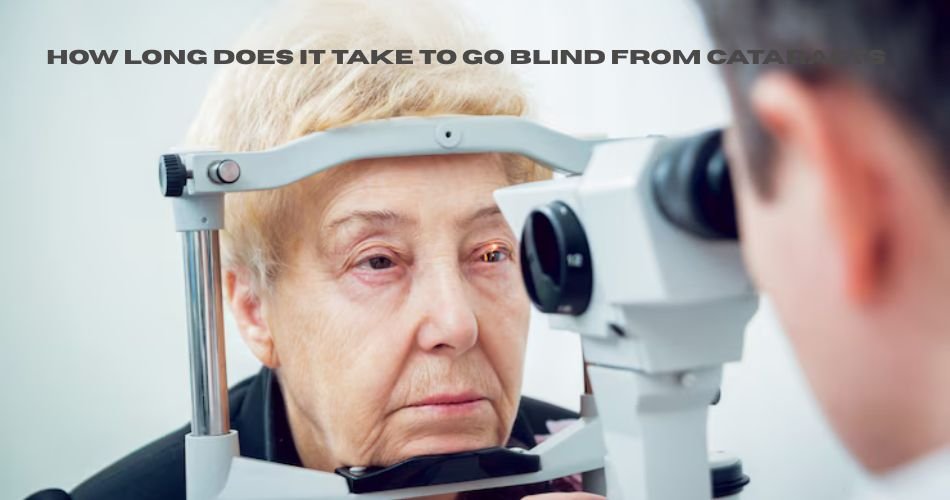Cataracts are one of the most common eye conditions affecting people worldwide, particularly those aged 60 and above. They occur when the natural lens of the eye becomes cloudy, leading to a gradual decline in vision. While the condition starts subtly, its progression can lead to severe visual impairment or even blindness if left untreated. Understanding the time it takes for cataracts to reach this advanced stage is crucial, especially for those at risk or already diagnosed. Timely diagnosis and treatment can not only prevent blindness but also restore near-perfect vision in many cases. This article will explore every aspect of cataract progression, from early symptoms to potential blindness, and provide insights on how to prevent it from reaching a critical point.
What Cataracts Really Are and How They Affect Your Eyes Over Time
Cataracts are the result of protein buildup on the eye’s lens, which interferes with the light entering the eye, leading to cloudy or blurry vision. The lens, which is normally clear and helps focus light on the retina, starts to harden and become opaque with age. This loss of clarity causes vision to become increasingly hazy, similar to looking through a foggy window. Over time, this opacity worsens, making it difficult to read, drive, or recognize faces. While cataracts are generally associated with aging, they can also result from injury, exposure to UV radiation, or certain health conditions. The progression of cataracts is typically slow, making it possible for some people to adapt to the vision loss until it significantly disrupts daily life.
Different Types of Cataracts and How Their Progression Rates Differ
There are several types of cataracts, each with distinct characteristics and progression speeds. Nuclear cataracts are the most common and usually form in the center of the lens. They progress gradually and may take several years to noticeably impair vision. Cortical cataracts affect the edges of the lens and often result in issues with glare and contrast, progressing at a moderate rate. Posterior subcapsular cataracts, which develop at the back of the lens, tend to affect vision more rapidly and are particularly troublesome when reading or in bright light. Because each type affects vision differently, the time it takes for cataracts to cause blindness can vary significantly depending on which type a person has.
Common Causes That Accelerate the Development of Cataracts
Aging is by far the most significant risk factor in cataract development, but several other causes can accelerate the process. Prolonged exposure to ultraviolet (UV) light without adequate eye protection increases the likelihood of developing cataracts earlier in life. Smoking is another major risk factor, as it introduces toxins that damage the eye’s proteins. People with diabetes are at greater risk due to fluctuating blood sugar levels that affect the eye’s internal structures. Additionally, long-term use of corticosteroid medications and previous eye injuries can speed up the onset of cataracts. Understanding these causes is essential for those who wish to slow down the progression or prevent the condition altogether.
Recognizing the Early Symptoms Before They Worsen
Cataracts don’t usually announce themselves with a bang. They sneak up quietly, with early symptoms that many dismiss or attribute to aging. One of the first signs is cloudy or blurred vision, which might feel like trying to look through frosted glass. Increased sensitivity to light, glare from headlights, and the appearance of halos around lights are also common indicators. Some people might find that their prescription for glasses or contacts changes more frequently than usual. Night vision becomes challenging, and colors may appear dull or faded. These early symptoms can persist for months or even years, and many adapt to the changes without realizing the underlying issue until it becomes severe.
The Timeline: How Fast Cataracts Can Lead to Blindness
In most cases, cataracts develop slowly over several years. For the average person with age-related cataracts, it may take 10 to 15 years from the initial onset of symptoms to reach a stage where vision is severely compromised. However, in more aggressive forms, such as posterior subcapsular cataracts or those related to diabetes, significant vision impairment can occur in just a few years. Without intervention, the cloudiness increases to the point where the lens becomes completely opaque, resulting in functional blindness. That said, “blindness” in this context means the inability to see clearly enough for daily tasks—not total darkness. But the impairment can be severe enough to prevent driving, reading, or even navigating around the home safely.
Health and Lifestyle Factors That Influence Cataract Progression
The speed at which cataracts progress isn’t the same for everyone. Genetics plays a huge role—if your parents or grandparents developed cataracts early, your chances of faster progression go up. Lifestyle factors such as smoking, heavy alcohol consumption, and prolonged sun exposure also accelerate the growth of cataracts. A poor diet lacking in antioxidants and key vitamins like A, C, and E can further worsen eye health. On the flip side, people who wear UV-protective sunglasses, eat a balanced diet rich in fruits and vegetables, and avoid smoking tend to experience slower progression and later onset of cataracts. Managing health conditions like diabetes and high blood pressure is also crucial in slowing down cataract development.
Can Cataracts Actually Make You Go Completely Blind?
Yes, if left untreated, cataracts can result in severe vision loss that qualifies as legal blindness. In extreme cases, where the lens becomes totally opaque, the ability to perceive light can also be lost. However, it’s important to understand that cataracts cause reversible blindness. Unlike other eye diseases like macular degeneration or glaucoma, the vision lost to cataracts can often be fully restored with surgery. The key is not to delay treatment until the cataract becomes too dense, which can make surgery more complicated and risky. That’s why recognizing symptoms early and acting on them is so vital.
Why Regular Eye Exams Are Key to Preventing Vision Loss
Even if you think your vision is fine, regular eye exams are crucial for catching cataracts early. Eye care professionals can detect cataracts long before symptoms become obvious. During a comprehensive exam, your optometrist or ophthalmologist will assess the clarity of your lens and determine the extent of the cloudiness. Early detection doesn’t necessarily mean immediate surgery, but it does allow for monitoring and lifestyle changes that could slow down progression. In some cases, updated prescriptions for glasses may be enough to manage vision problems for several years.
When Is the Right Time to Consider Cataract Surgery?
Many people wait until their vision is significantly impaired before considering surgery, but this isn’t always the best approach. The ideal time for cataract surgery is when the condition begins to interfere with your everyday activities—like driving, reading, or recognizing faces. Waiting too long can make the surgery more complicated and increase the risk of complications. On the other hand, having surgery too early might not be necessary if your vision is still functional with corrective lenses. It’s a personal decision, but one that should be guided by an experienced eye doctor who understands your lifestyle needs.
The Role of Surgery in Reversing Cataract-Induced Blindness
Cataract surgery is one of the most common and successful procedures in modern medicine. It involves removing the cloudy lens and replacing it with a clear, artificial intraocular lens (IOL). The procedure takes about 15 to 30 minutes and is typically done under local anesthesia. Recovery is quick, with most patients noticing a significant improvement in vision within 24 to 72 hours. If cataracts were the sole cause of blindness, vision is usually restored almost entirely. Complications are rare but can include infection, swelling, or retinal detachment in severe cases. Still, the success rate of cataract surgery is above 95%, making it a highly reliable solution.
Tips for Slowing Down the Progression of Cataracts Naturally
While you can’t reverse cataracts without surgery, you can certainly slow them down. Wearing sunglasses that block UVA and UVB rays is one of the easiest ways to protect your eyes. Eating a diet rich in antioxidants—such as leafy greens, citrus fruits, and carrots—can also help. Avoiding smoking and excessive alcohol consumption reduces oxidative stress on the eyes. Managing chronic diseases like diabetes and hypertension will not only improve your overall health but also protect your vision. Lastly, don’t skip your annual eye exams; early detection is your best defense against rapid progression.
Conclusion
The question of how long does it take to go blind from cataracts doesn’t have a one-size-fits-all answer. For most people, it’s a slow process that unfolds over many years, allowing ample time for diagnosis and treatment. However, ignoring the signs and delaying treatment can lead to significant and even complete vision loss. The good news is that cataract-related blindness is almost always reversible through surgery. By staying proactive with your eye health, embracing healthy habits, and seeking timely medical advice, you can protect your sight and enjoy a clear, vibrant view of the world for years to come.






